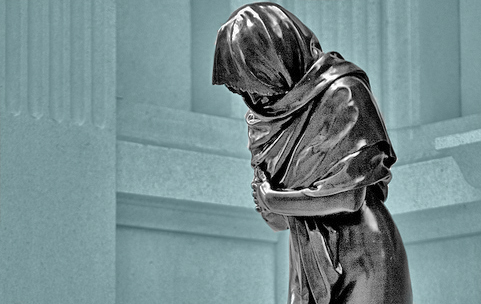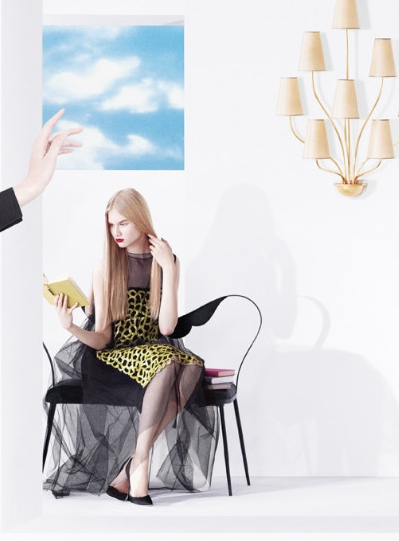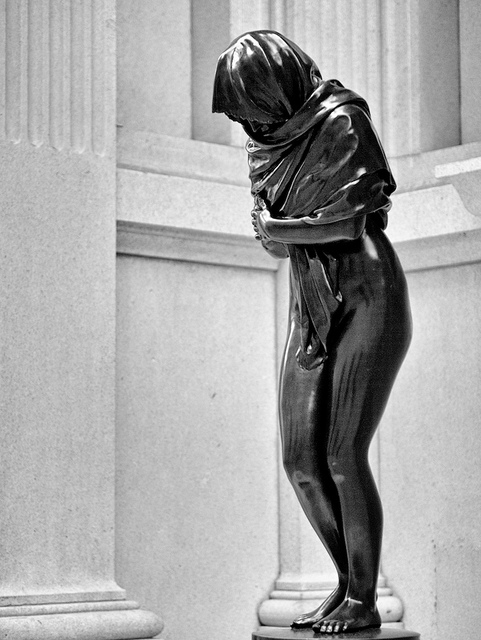
—Uzoamaka Maduka
The earliest theory of art—put forward by Plato in The Republic—argued that art was mimesis, that is, imitation of reality. The notion of art as a “mirror” was only a few steps away from this initial idea, and has stayed with us into modern times (think of Hamlet, declaring that “the purpose of playing” is to hold “the mirror up to nature”). Over two thousand years after The Republic, Tolstoy, in the throes of a spiritual crisis, would turn away from fiction, explaining that although it’d been “pleasant to look at life in the mirror of art,” once he “knew life to be meaningless and terrible, the play in the mirror could no longer amuse [him].”
When I got home from a poetry reading the other night, this Dior ad on the back of a magazine caught my eye. Because of the model’s facial expression, I mistook the slender yellow book in her hand for a compact mirror. This photograph of a woman, checking her hair in her book, somehow conveys much of my disappointment in some contemporary writing.
—Alyssa Loh
If there can be such a thing as a staff un-pick, I present Jean-Antoine Houdon’s La Frileuse, who can be found shivering in the Petrie Court of the Metropolitan Museum of Art.
A brief rundown of why the statue’s contemptible: La Frileuse, which translates to “The Shivering Girl,” has technically observed the advice of mothers everywhere: “Wear a hat!” Unfortunately, following the letter of this law has left her with nothing to cover what our mothers would have probably preferred us to cover. I think Houdin knew, and encouraged us to imagine, that we are seeing her days or months before she has no choice but prostitution. He might accidentally be the father of the pin-up, the conceit that something just snapped open, honest!, and reminded us of the bizarre but unshakeable trope that a bit of coverage is the difference between a woman who will versus a woman who must. I profoundly dislike that we are being treated to her lovely body at the expense of her physical discomfort. This anger is so intense that I am yanked back into a childhood confrontation with art, when we’re still sorting out the difference between reality and mimesis.
But I have an even larger objection. Houdon prompts the horrible combination of pity and attraction. This is a particularly harmful and insidious human dynamic, plucking two powerful cords that reverberate longer than is good for us. To feel a sense of pity is to be caught up in a fantasy of assistance, creating virtuous concern inspired by a comparison with one’s own situation. The feeling of pity is inherently, unshakably one of superiority, even if it’s only one of luck and not of virtue. Pity looks down on the person—it can’t help it. With pity already so problematic, the introduction of attraction is a fatal blow. Loveliness creates in us an anxious revelation of our unworthiness, and an unhappy anticipation of its unattainability, leaving us powerless, frantic with the desire to be noticed and deserving.
The cocktail of pity and attraction precludes any kinship we might feel with La Frileuse. Thanks to Houdon’s almost perfect halving of pity and desire, it’s impossible experience empathy, to remember some coldness we’ve experienced ourselves, to recall such a vulnerability and exposure. As if anticipating our feelings for her, there are two views of La Frileuse. Downstairs in the Petrie Court itself, she lives on a surprisingly large pedestal, compelling you to look up to see her. The other view is from floor above the Petrie Court, where you can look down on her from the window above.
—Alma Vescovi



